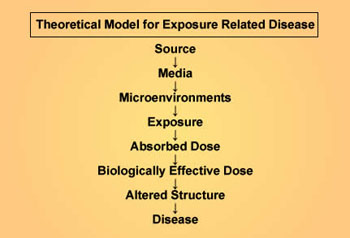|

Exposure scenarios need
to be constructed based on:
- Current
and potential future use of contaminated areas
- The
potential for the hazardous substance to cause adverse effects.
- The
audience of the risk assessment and the questions that you ultimately
need to answer. For example, community members will be
interested in how much exposure their children will receive, and risk
managers want to know the worst case scenario for the maximum exposure
possible.
Then,
for each exposure scenario one must collect data and calculate estimated
doses
- Potential
dose (e.g. the amount of contaminant in the air)
- Applied
dose, i.e., the intake or administered dose or the amount actually
taken in (e.g. inhaled)
- Absorbed
dose i.e., the uptake or internal dose or delivered dose(e.g., the
amount absorbed by the lung into the blood stream)
- Biologically
effective dose, i.e. the dose at the target tissue.
For each scenario calculations must take
into account not only the receptors (who might be exposed) and their
activities, but also the dimensions of :
-
Intensity: concentration of exposure
-
Frequency: number of times exposed
-
Duration: length of exposure. Was it acute (hours to days) or
chronic (many years). For example, the response to 30 cups of coffee
consumed during a 24 hour period would certainly be different from 1
cup per day over a period of 30 day.
The Average Daily Dose:
The
final step of the exposure assessment is to calculate the average daily
dose (ADD) for each contaminant of concern and each exposure route. Each
ADD reflects exposure to a single COC by a specific exposure route.
If multiple exposure routes exist for the same COC, then the
sum of the ADDs for each route serves as a measure of total dose.
If there are multiple COCs, then multiple ADDs must be calculated.
For example,
an average daily dose for ingestion of residential drinking water could be
calculated from:
Average
Daily Dose (mg/kg body weight/day) = (CW x IR x EF x ED)/ (BW
x AT)
where:
CW = Chemical concentration in water (mg/liter)
IR = Ingestion rate
(liters/day)
EF = Exposure frequency
(days/year)
ED = Exposure duration (years)
BW = Body weight
(kg)
AT = Averaging time (days) |